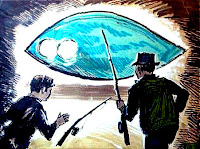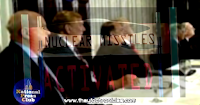| In a remarkable July 2025 interview with Chris Lehto on "Lehto Files," former CIA Operations Officer Jim Semivan delivered what may be the most candid assessment of the UAP phenomenon ever provided by a senior intelligence official. After 34 years in the CIA, |
By The UFO Chronicles
2025 |
This isn't a statement born of ignorance, but rather the honest admission of someone who has seen classified evidence, has interacted with people in the legacy programs studying UAPs for eight decades, and personally experienced the phenomenon that has baffled the world's most sophisticated intelligence apparatus.
Semivan's journey from UAP skeptic to insider began with a personal experience in the early 1990s that fundamentally altered his worldview. What he describes as a "typical encounter" involved classic abduction scenario elements: awakening immobilized in bed to find three entities at the foot of his bed, described as resembling "Bibendum" (the Michelin tire man) but in black armor rather than white. The experience included fragmented memories of being outside his house with his wife, observing three orbs in the sky that merged into one before shooting away.
More significantly, both Semivan and his wife experienced unexplained physical effects. His wife suffered from unexplained bleeding for 17 days, while Semivan discovered a perfectly round hole "the size of a pencil eraser" on the back of his neck. When he shared this experience with a deep-cover CIA officer, the colleague immediately asked about bleeding and neck marks, revealing an internal awareness within the intelligence community about such phenomena.
This encounter connected Semivan to what he describes as "the invisible college" - a network of intelligence professionals, military personnel, and scientists who have been quietly studying UAPs within the government for decades.
Perhaps the most revelatory aspect of Semivan's testimony concerns the intelligence community's long-standing engagement with UAPs. According to Semivan, the phenomenon has been studied by government programs since the 1940s, with the CIA and Air Force taking the lead after President Truman's National Defense Act of 1947. The Roswell incident, occurring near a nuclear facility, marked the beginning of what would become an eight-decade investigation.
The startling revelation: despite all this time, resources, and access to classified evidence, the intelligence community remains fundamentally baffled. Semivan emphasizes that even those with "cosmic clearances" - the highest levels of security access - admit they don't understand the phenomenon. They may possess "downed craft" and "startling" photographic evidence, but the essential nature of what they're dealing with remains a mystery.
Semivan characterizes UAPs as the ultimate "wicked problem" - a term from systems theory describing issues with so many interconnected elements that they become essentially unsolvable1. Unlike poverty or climate change, which are complex but theoretically addressable, the UAP phenomenon presents challenges that transcend our current scientific, philosophical, and sociological frameworks.
The phenomenon appears to be multidisciplinary, involving not just aerospace technology but consciousness, quantum mechanics, biology, sociology, and spirituality. It demonstrates what Semivan describes as "25th-century physics" to our 21st-century understanding. The entities involved appear to possess capabilities that suggest reality itself might be malleable, including the ability to:
• Control human consciousness and plant memories
• Operate with apparent omniscience
• Manipulate physical reality in ways that defy known physics
• Remain "classically indifferent" to human concerns while demonstrating godlike capabilities
One of the most thought-provoking aspects of Semivan's testimony concerns the dangers of disclosure. He distinguishes between "limited disclosure" and "catastrophic disclosure," with the latter involving a presidential announcement revealing the full extent of government knowledge about non-human intelligences.
The potential consequences of such disclosure are staggering. Semivan cites studies suggesting that if 25% of the population becomes sick, ill, or simply disassociates from reality, civilization could collapse - food production would cease, essential services would fail, and social order would break down. The psychological impact of learning that humanity is not at the top of the food chain, that we may be viewed as "property" by superior intelligences, could be devastating.
Furthermore, catastrophic disclosure would create an information vacuum that would be filled by unreliable sources. Without complete answers from the government, public figures, experiencers, and various media personalities would shape the narrative, potentially creating "new religions" based on incomplete or inaccurate information.
Perhaps most unsettling is Semivan's suggestion that the phenomenon itself may be controlling the disclosure process. He describes the entities as "classically indifferent" to humanity while possessing capabilities that appear godlike. This indifference, combined with their apparent control over when and how they reveal themselves, suggests that any disclosure timeline may not be entirely in human hands.
The phenomenon's relationship with nuclear technology is particularly concerning. Semivan notes its "affinity for nuclear material," pointing to incidents at nuclear facilities worldwide. This pattern suggests either a monitoring function or a more active intervention in human affairs related to our most destructive capabilities.
Semivan's most philosophical observations concern the nature of reality itself. Drawing parallels to quantum mechanics, he suggests that our understanding of physical reality may be fundamentally flawed. If quantum physicists tell us that space is mostly empty and reality is based on probabilities rather than mechanistic certainties, what does this say about the nature of consciousness and existence?
The phenomenon appears to exist at the intersection of the physical and consciousness, suggesting that our materialistic, mechanistic worldview may be incomplete. Some individuals, through mystical experiences or psychedelic substances like DMT, seem to access similar non-ordinary states of consciousness where contact with non-human intelligence occurs.
Despite his concerns about catastrophic disclosure, Semivan acknowledges significant potential benefits. Full disclosure could:
• Generate entirely new academic disciplines • Revolutionize our understanding of physics, consciousness, and realityThe challenge lies in achieving these benefits while minimizing the risks of social collapse and psychological trauma.
• Provide humanity with its "real history" and birthright to truth
• Unite humanity against an external challenge (echoing Ronald Reagan's famous speculation)
• Validate the experiences of countless individuals who have encountered the phenomenon
Throughout the interview, Semivan provides insights into the culture and operations of the CIA that illuminate why the UAP issue has been handled as it has. The intelligence community operates on a strict need-to-know basis, with information compartmentalized to prevent unauthorized disclosure. Presidents typically receive general briefings but may not access the most classified "second part" of briefings without extensive waivers and commitments.
The CIA's mission to "prevent another Pearl Harbor" means that phenomena demonstrating superior capabilities must be studied, regardless of how little they're understood. However, the agency's inability to develop effective responses or countermeasures after eight decades of study speaks to the phenomenon's truly anomalous nature.
Semivan's ultimate position is one of cautious support for disclosure. He doesn't oppose revealing the truth but emphasizes the need for responsible management of the process. He quotes T.S. Eliot: "Humankind cannot bear very much reality", suggesting that the timing and method of disclosure are crucial considerations.
His advice to researchers and podcasters like Lehto is to continue their work, as open dialogue is essential for preparing humanity for whatever revelations may come. He advocates for exploring "corollary areas" - mysticism, consciousness studies, near-death experiences, and other phenomena that might provide context for understanding our place in a larger, more complex reality.
In concluding his remarkable testimony, Semivan reflects on what it means to be human in the face of such overwhelming mysteries. Drawing from Aldous Huxley's deathbed words, he emphasizes the importance of kindness and compassion. Perhaps in acknowledging our limitations and embracing our humanity, we can better prepare for whatever truths about the phenomenon may eventually emerge.
Jim Semivan's interview represents a watershed moment in UAP disclosure - not because it provides definitive answers, but because it offers something perhaps more valuable: an honest assessment of the limits of human knowledge when confronted with the truly unknown. After 34 years in the CIA and decades of studying the phenomenon, his central message remains: "We don't know what the phenomenon is."
This admission, coming from someone with access to the most classified information available, should humble us all. It suggests that the path forward requires not just scientific rigor and government transparency, but also philosophical humility and psychological preparation for realities that may challenge our most fundamental assumptions about existence itself.
The phenomenon, whatever it is, appears to be both ancient and ongoing, both physical and consciousness-related, both indifferent to humanity and deeply involved in our affairs. Understanding it may require not just new science, but new ways of thinking about reality, consciousness, and our place in the cosmos.
As Semivan suggests, we may be living in what he calls a "consensus reality" rather than the true reality. The question is whether humanity is ready to discover what lies beyond the veil of our current understanding - and whether we can handle the truth when it finally emerges.
See Also:
CIA Veteran Discloses Alien Abduction During Knapp Interview
REPORT YOUR UFO EXPERIENCE










.png)













